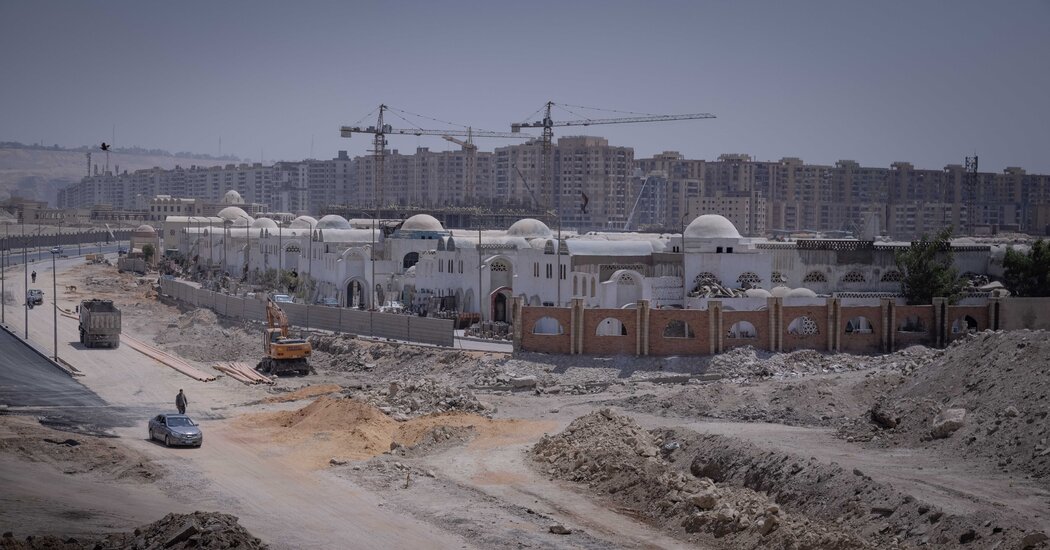Ancient tombs have been shattered. Gardens have vanished, and with them many of Cairo’s trees.
A growing number of historic but shabby working-class neighborhoods have all but disappeared, too, handed over to developers to build concrete high-rises while families who have lived there for generations are pushed to the fringes of the sprawling Egyptian capital.
Few cities live and breathe antiquity like Cairo, a sun-strafed, traffic-choked desert metropolis jammed with roughly 22 million people. But President Abdel Fattah el-Sisi is modernizing this superannuated city, fast.
He is trying to buff its unruly complexity into a place of efficient uniformity — the traffic tamed, the Nile River promoted as a tourist attraction, the slums cleaned up and their residents rehoused in modern apartments. And he considers the construction as one of the major accomplishments of his tenure.
“There is not a single place in Egypt that has not been touched by the hand of development,” Mr. el-Sisi proclaimed in a recent speech.
So the old stone and brick must go, paved over by concrete. New elevated highways undulate over ancient cemeteries, riding skinny struts like giant gray roller coasters. A freshly built walkway lined with fast-food joints runs along the Nile, the entrance fee out of reach for many Egyptians, with consumer inflation running at about 38 percent annually
New roads, overpasses and offramps materialize so quickly that taxi drivers and Google Maps alike can barely keep up. And Cairo is not just being made over, but replaced: Mr. el-Sisi is erecting a supersized new capital, all right angles, tall towers and luxury villas, in the desert just outside of Cairo.
The estimated cost of the new capital alone is $59 billion, with billions more going to other construction projects, including roads and high-speed trains meant to link the new capital to the old. Most of it was paid for by debt, the sheer mass of which has crippled Egypt’s ability to handle a deep economic crisis set off by Russia’s invasion of Ukraine.
A few weeks ago, the modernization efforts reached Fustat, the city’s most ancient district, founded as Egypt’s capital centuries before Cairo was even a thought
A district official knocked on the door of the artist Moataz Nasreldin and told him to start packing up Darb 1718, the popular cultural center he founded in the neighborhood 16 years ago. The government would be widening the road behind it to build an elevated highway, Mr. Nasreldin, 62, said the official told him.
Darb, along with some of the nearby pottery workshops run for decades by local craftsmen and some nearby housing, would have to go.
As often happens nowadays in Egypt, where stories abound of government excavators and bulldozers appearing on private property with barely any notice, information about the decision was scant. Mr. Nasreldin and the owners of the pottery workshops said local officials had not presented a written demolition order or any other paperwork.
“Every day, you wake up and you don’t know what’s going to happen,” said Mohamed Abdin, 48, who owns one of the workshops slated for destruction. He said his family has been making pottery in the area since the 1920s
Some Cairenes are proud of the construction, seeing it as tangible evidence of progress
“These are the developments that the country had to see,” a pro-Sisi TV presenter, Ahmed Moussa, said on his program recently.
Others say they no longer recognize their own city.
“If you were being invaded, all what you’d care about is your monuments, your trees, your history, your culture,” said Mamdouh Sakr, an architect and urbanist. “And now, it’s all being destroyed, without any reason, without any explanation, without any need.”
Most of the time, Egyptians simply submit, powerless before the state. But not Mr. Nasreldin, who sued to stop the destruction and raised a fuss on social media. The municipality said it was reconsidering the plans, but did not say when a final decision would be made or who would make it.
Construction of roads, bridges and major projects such as the new capital is usually overseen by Egypt’s powerful military. It was the military that elevated Mr. el-Sisi, a former general, to power in 2013 amid mass protests demanding the ouster of the country’s first democratically elected president, who took office after the country’s 2011 Arab Spring uprising.
Cairenes, as this city’s residents are known, who have contacted government officials to push back against the development say those in charge tend to wave off experts’ advice and dismiss the concerns of local residents. Only in isolated cases have preservationists managed to save historical monuments
The marvels of capitalism.
More so unchecked authoritarianism in this case, one would hope that even in places like the US they wouldn’t just bulldoze cultural sites for ‘progress’. Keep in mind that this Egyptian fellow recently built the world’s tallest flagpole, and if you look at the list of record heights there’s a bit of a pattern
You have to remember that real people live in Cairo, not tourist attractions. If Egypt wants to diversify and grow their economy beyond sordid tourism, they have a right to it. Westerners like to visit 3rd world countries, marvel at ancient ruins while sipping their daiquiries and posing with their iToddler phones before flying back home. The locals do souless dances and beg for tips. Colonialism in the form of enlightened tourism.
These are locals complaining, not tourists. And they are complaining about the destructive way in which development is taking place, not claiming that Egypt should not develop.





